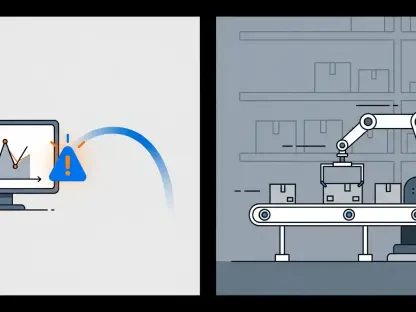Google has introduced a significant upgrade to its AI-based chat assistant, Gemini, transitioning from the Gemini 1.0 model to the new and improved Gemini 1.5 Flash model. This advancement focuses on addressing several limitations of its predecessor, primarily in terms of speed and efficiency, and introduces a groundbreaking feature: fine-tuning AI-generated images. This development signifies a broader shift in the industry towards creating more user-friendly and efficient AI tools, aiming to improve the overall user experience by incorporating features that save time and offer greater control.
Introducing the Gemini 1.5 Flash Model
Enhanced Speed and Efficiency
The Gemini 1.5 Flash model boasts a marked increase in speed and efficiency compared to its predecessor, the Gemini 1.0 version. This enhancement aims to streamline user interactions, providing quicker and more responsive AI-generated results. For users engaged in tasks requiring rapid processing times, such as content creation and dynamic query management, these improvements help reduce delays and maintain workflow momentum. The faster speed ensures that users can achieve their goals with minimal interruption, making the AI assistant more reliable for time-sensitive activities.Increased efficiency in the Gemini 1.5 Flash model also means that the AI can manage more complex tasks without a significant drop in performance. By optimizing the underlying algorithms and hardware utilization, Google has managed to ensure that users experience fewer lags and more seamless interactions. This upgrade is especially crucial for professional environments where productivity is paramount and every second counts. Consequently, the enhanced speed and efficiency of Gemini 1.5 bolster its appeal among tech-savvy individuals and businesses seeking high-performance AI solutions.
Support for 32k-Long Context Window
Another notable aspect of the Gemini 1.5 Flash model is its expanded support for a 32k-long context window. This feature significantly enhances the AI’s ability to maintain context over extended conversations and handle more complex textual inputs. Users who juggle multiple intricate tasks or require detailed, long-term analyses will find this particularly useful. The extended context window ensures that the AI assistant can provide more coherent and contextually accurate responses, even when handling large volumes of information.The support for a longer context window also means that users do not have to repeat information or continually remind the AI of previous points in the conversation. This leads to smoother and more natural interactions, mirroring the fluidity of human communication. Additionally, for applications in customer support, research, and extensive data analysis, the ability to maintain and understand extended context can significantly improve the accuracy and relevance of the AI’s outputs.
Fine-Tuning of AI-Generated Images
Addressing the Flaws of Gemini 1.0
One of the major pain points with the Gemini 1.0 model was the inefficiency in handling image generation errors. Users often found themselves having to start from scratch if the AI-generated image didn’t align with their expectations, leading to significant time wastage and frustration. This lack of flexibility did not cater well to users who needed minor adjustments rather than complete overhauls, thus rendering the system less efficient for those requiring precision and quick customization.With the introduction of the Gemini 1.5 Flash model, Google aims to resolve these issues by incorporating a feature that allows users to fine-tune already generated images. This approach acknowledges that users may be generally satisfied with the core aspects of the image but need minor tweaks to achieve their desired result. By addressing these flaws, Google is enhancing the user experience and making the image generation process more efficient and user-centric.
Introduction of the Fine-Tuning Tool
To address this issue, Google has introduced a fine-tuning tool in its beta app version 15.29.34.29 for Android. This feature empowers users to tweak details on an already generated image using text prompts, drastically reducing the time and effort needed for corrections. Rather than generating a new image from scratch, users can make precise modifications without altering the overall design, providing a more tailored and user-friendly experience.The fine-tuning tool’s ability to make micro-adjustments ensures that users can maintain the integrity of their initial design while refining specific elements. This capability is particularly beneficial for creative professionals and casual users alike, as it offers a level of control and precision that was previously unavailable. The introduction of this tool indicates a significant step towards a more customizable and intuitive AI interaction, aligning with the broader goal of enhancing user satisfaction with AI-generated content.
Dual Approach for Image Adjustments
Text Prompts for Refinement
The fine-tuning feature employs text prompts, enabling users to specify changes needed in certain parts of the image. This method allows for efficient communication of the desired adjustments, ensuring that users get closer to their vision without extensive back-and-forth modifications. The use of text prompts simplifies the image editing process, making it more accessible to users who may not have advanced technical skills but still need precise control over their images.Text prompts for refinement also allow for more accurate and targeted adjustments, as users can clearly articulate the changes they need. This level of specificity helps the AI to better understand and execute the desired modifications, leading to higher quality results. By leveraging the power of natural language processing, the fine-tuning tool can interpret and implement complex instructions, thereby enhancing the overall user experience and making image editing more efficient and enjoyable.
Manual Circling for Stylistic Edits
In addition to text prompts, users can manually circle specific areas of the image they wish to edit. This dual approach is especially beneficial for users operating on phones equipped with a stylus, simplifying the correction process. The combination of text and manual edits makes the tool intuitive and accessible, catering to a broader audience. By allowing users to visually highlight the areas that need adjustment, the fine-tuning tool provides a more interactive and hands-on editing experience.Manual circling for stylistic edits offers a level of precision that is difficult to achieve with text prompts alone. Users can directly indicate the exact spots that require changes, ensuring that the AI applies the modifications accurately. This feature is particularly useful for intricate design work, where exactness in detail is crucial. Overall, the dual approach of combining text prompts with manual circling provides a comprehensive and versatile solution for image editing, enhancing the functionality and appeal of the Gemini 1.5 Flash model.
User-Centric Improvements for Enhanced Experience
Flexibility and Precision in Design
The new fine-tuning capability means users no longer need to compromise their initial design intent. They can now make minor, precise adjustments while preserving core elements of their images. This flexibility is vital for users requiring exactness in their creative outputs, contributing to more satisfactory and efficient use of the AI. By offering the ability to refine specific aspects of an image, Google ensures that users can achieve their desired results without unnecessary complications.This newfound flexibility and precision in design also foster greater creativity and experimentation. Users can explore various design options and make iterative improvements without the fear of losing their original work. This capability empowers users to push the boundaries of their creativity and produce higher quality outputs. In turn, this enhancement bolsters user confidence in the AI’s capabilities, fostering a more productive and engaging interaction with the technology.
Boosted User Satisfaction and Engagement
By eliminating repetitive image creation processes, Google significantly reduces time wastage. Users frequently working with AI-generated visual content will find their operations more streamlined, leading to higher satisfaction levels and increased engagement with the AI assistant. The reduction in redundant tasks not only boosts productivity but also enhances the overall user experience, making the technology more appealing and valuable to users across various domains.Higher user satisfaction and engagement can also translate into increased loyalty and advocacy for Google’s AI solutions. As users experience the benefits of the new features, they are likely to integrate the AI more deeply into their workflows and recommend it to others. This positive feedback loop can drive broader adoption and spur further innovations, solidifying Google’s position as a leader in AI technology. By focusing on user-centric improvements, Google is setting a new standard for what users can expect from AI-powered tools.
Broader Industry Trends and Google’s Strategy
Aligning with AI Development Trends
This update aligns with industry-wide trends focusing on refining user interfaces and experiences in AI models. The shift towards more intuitive and user-friendly features is evident across various tech giants, reinforcing the importance of reducing user effort and enhancing interaction quality. Companies are increasingly recognizing that the success of AI technologies hinges on their ability to seamlessly integrate into users’ daily lives and improve their efficiency and engagement.Enhancement of user interfaces and experience is becoming a standard in AI development, as evidenced by similar efforts from Google’s competitors. By prioritizing user satisfaction and ease of use, tech companies are driving innovation in ways that make AI tools more accessible and effective for a broad audience. This trend highlights the industry’s commitment to making AI not just smarter, but also more practical and user-friendly.
Enhancing User Trust and Satisfaction
In parallel, Google is also enhancing user trust and satisfaction through improved safety standards across platforms, such as YouTube. This holistic approach ensures that whether users are generating content or consuming it, their experience remains secure and enjoyable. By implementing robust measures to protect user data and promote a safe online environment, Google addresses critical concerns that users have about privacy and security.The concerted effort to enhance user trust and satisfaction across different platforms reflects Google’s broader strategy of fostering a positive and secure user experience. By aligning their initiatives in AI development and platform safety, Google aims to build a cohesive ecosystem where users feel confident and satisfied with their interactions. This strategy not only benefits individual users but also enhances Google’s reputation and competitive edge in the tech industry.
Future Implications and Expectations
Testing and Anticipation
While the fine-tuning tool is currently in beta testing, there is keen anticipation for its stable release. Users are eager to incorporate these enhancements into their regular workflows, expecting substantial improvements in efficiency and satisfaction. The beta testing phase allows Google to gather valuable feedback and make necessary adjustments before the widespread rollout, ensuring that the final product meets users’ expectations and needs.The anticipation for the stable release underscores the growing demand for more advanced and user-friendly AI tools. As users begin to experience the benefits of the fine-tuning tool, it is likely that they will advocate for its broader adoption and integration into other applications. This momentum can drive further innovation and set new standards for AI capabilities, pushing the industry towards more sophisticated and user-centric solutions.
Setting New Standards in AI Content Generation
Google has rolled out a major enhancement to its AI-driven chat assistant, transitioning from the Gemini 1.0 model to the more advanced Gemini 1.5 Flash model. This new version targets several shortcomings of its predecessor, particularly in terms of speed and efficiency. A standout feature of the Gemini 1.5 Flash model is its ability to fine-tune AI-generated images, a capability that has not only set a new standard but also broadened the scope of what AI tools can achieve. This move is indicative of a larger industry trend focusing on the creation of more user-friendly and efficient AI mechanisms. The introduction of such features is designed to enhance the user experience by making these AI tools not only faster but also more intuitive, ultimately saving users time and providing them with greater control over their interactions. Google’s step forward with the Gemini 1.5 Flash underscores the ongoing commitment in tech industries to innovate and meet increasingly sophisticated user demands, aiming to integrate convenience and advanced functionalities seamlessly into everyday use.









